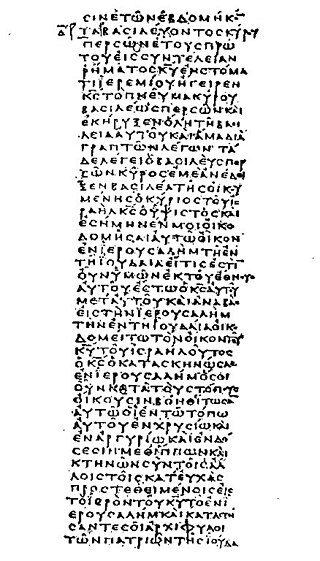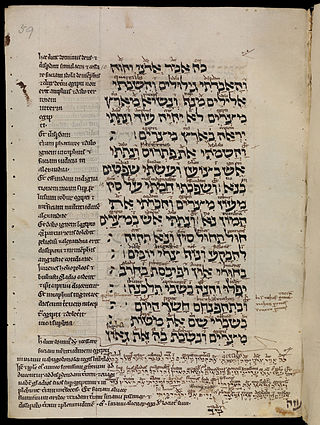
The Septuagint, sometimes referred to as the Greek Old Testament or The Translation of the Seventy, and often abbreviated as LXX, is the earliest extant Greek translation of the Hebrew Bible from the original Hebrew. The full Greek title derives from the story recorded in the Letter of Aristeas to Philocrates that "the laws of the Jews" were translated into the Greek language at the request of Ptolemy II Philadelphus by seventy-two Hebrew translators—six from each of the Twelve Tribes of Israel.
Anakim are mentioned in the Bible as descendants of Anak.
Ophir is a port or region mentioned in the Bible, famous for its wealth. Its existence is attested to by an inscribed pottery shard found at Tell Qasile in 1946, dating to the eighth century BC, which reads "gold of Ophir to/for Beth-Horon [...] 30 shekels" The location of Ophir is unknown, though the find confirms it as a real place from which gold was imported.

Nabu is the Babylonian patron god of literacy, the rational arts, scribes, and wisdom. He is associated with the classical planet Mercury in Babylonian astronomy.
Aroer is the name of two biblical cities in the Transjordan, in what is today the Kingdom of Jordan.

Emanuel Tov, is a Dutch–Israeli biblical scholar and linguist, emeritus J. L. Magnes Professor of Bible Studies in the Department of Bible at the Hebrew University of Jerusalem. He has been intimately involved with the Dead Sea Scrolls for many decades, and from 1991, he was appointed Editor-in-Chief of the Dead Sea Scrolls Publication Project.
Kir of Moab is mentioned in the Hebrew Bible as one of the two main strongholds of Moab, the other being Ar. It is probably the same as the city called Kir-haresh, Kir-hareseth, and Kir-heres. The word Kir alludes to a wall or fortress. By the 5th century BC, the city name had been adapted to the common language of the time, Aramaic, becoming Karak in Moab, and later the Roman and Byzantine periods, Charachmoba. The Arabic name until today is al-Karak.
Isaiah 11 is the eleventh chapter of the Book of Isaiah in the Hebrew Bible or the Old Testament of the Christian Bible. This book contains prophesies attributed to the prophet Isaiah. This chapter can be divided into two main parts, verses 1–9 and verses 11–16, with verse 10 as a connecting statement between them. The New International Version entitles the chapter "The Branch from Jesse".

Isaiah 15 is the fifteenth chapter of the Book of Isaiah in the Hebrew Bible or the Old Testament of the Christian Bible. This book contains the prophecies attributed to the prophet Isaiah, and is one of the Books of the Prophets. This chapter and the following chapter deal with the forthcoming history of Moab.

Isaiah 16 is the sixteenth chapter of the Book of Isaiah in the Hebrew Bible or the Old Testament of the Christian Bible. This book contains the prophecies attributed to the prophet Isaiah, and is one of the Books of the Prophets. This chapter continues the proclamation concerning Moab commenced in the previous chapter.
Isaiah 17 is the seventeenth chapter of the Book of Isaiah in the Hebrew Bible or the Old Testament of the Christian Bible. This book contains the prophecies attributed to the prophet Isaiah, and is one of the Books of the Prophets. The New King James Version describes this chapter as a "proclamation against Syria and Israel".
Isaiah 20 is the twentieth chapter of the Book of Isaiah in the Hebrew Bible or the Old Testament of the Christian Bible. This book contains the prophecies attributed to the prophet Isaiah.
Isaiah 22 is the twenty-second chapter of the Book of Isaiah in the Hebrew Bible or the Old Testament of the Christian Bible. This book contains the prophecies attributed to the prophet Isaiah, and is one of the Books of the Prophets. This chapter contains a prophecy against "untimely rejoicing in Jerusalem" and "a threefold prediction of Shebna's fall and of Eliakim's elevation."
Isaiah 23 is the twenty-third chapter of the Book of Isaiah in the Hebrew Bible or the Old Testament of the Christian Bible. This book contains the prophecies attributed to the prophet Isaiah, and is one of the Books of the Prophets. This chapter foretells the destruction of Tyre due to its pride, its rising again, and its conversion to God.
Isaiah 24 is the 24th chapter of the Book of Isaiah in the Hebrew Bible or the Old Testament of the Christian Bible. This book contains the prophecies attributed to the prophet Isaiah, and is one of the Books of the Prophets. Chapters 24-27 of Isaiah constitute one unit of prophecy sometimes called the "Isaiah Apocalypse". Chapter 24 contains the prophecy on the destruction of Judah for its defilements and transgressions, while a remnant will praise God, and God, by his judgments on his people and their enemies, will advance his kingdom.

Ezekiel 25 is the twenty-fifth chapter of the Book of Ezekiel in the Hebrew Bible or the Old Testament of the Christian Bible. This book contains the prophecies attributed to the prophet/priest Ezekiel, and is one of the Books of the Prophets. This chapter contains the oracles against four nations: Ammon, Moab, Edom, and Philistia. The prophecies of God's vengeance against these and other foreign nations are recorded in other books of the prophets such as Isaiah, Jeremiah and Amos.

Jeremiah 48 is the forty-eighth chapter of the Book of Jeremiah in the Hebrew Bible or the Old Testament of the Christian Bible. This book contains prophecies attributed to the prophet Jeremiah, and is one of the Books of the Prophets. This chapter is part of a series of "oracles against foreign nations", consisting of chapters 46 to 51. In particular, chapters 46-49 focus on Judah's neighbors. This chapter contains the poetic oracles against Moab.

1 Samuel 22 is the twenty-second chapter of the First Book of Samuel in the Old Testament of the Christian Bible or the first part of the Books of Samuel in the Hebrew Bible. According to Jewish tradition the book was attributed to the prophet Samuel, with additions by the prophets Gad and Nathan, but modern scholars view it as a composition of a number of independent texts of various ages from c. 630–540 BCE. This chapter contains the account of David's escape from Saul's repeated attempts to kill him and the massacre of the priests in Nob. This is within a section comprising 1 Samuel 16 to 2 Samuel 5 which records the rise of David as the king of Israel.
Textual variants in the Numbers concerns textual variants in the Hebrew Bible found in the Book of Numbers.






